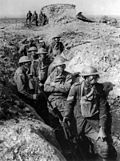Weapons of World War I
Major advances were made to weapon technology during World War I. There were better grenades, flame throwers, poison gas, and artillery. The submarine, warplane and the tank were new weapons.[1]
Both sides used a much better heavy machine gun than they had used before in Europe. Four to six people worked one. They fired 400 to 600 bullets per minute. The machine guns got too hot and needed water on them. This kind of gun was invented in 1884 by Hiram Maxim.[2] The German version was the MG08. The British used the Vickers machine gun, which was very safe and easy to use. The machine guns changed how war went; and killed many soldiers. Because they sometimes got too hot, they could be slow. In case that one of the crew of the machine gun were shot, the whole squad were trained to fill their spot. As the war progressed, more machine guns were used in trench warfare in combination with barbed wire defensive positions, making them the most deadly weapon on the battle field.
The normal British army rifle was the Lee Enfield 0.303. This was made in 1907 by James Lee. The Lee Enfield could fire twelve bullets per minute. The Germans used the Mauser rifle made in 1898 by Paul Mauser. This was an excellent rifle, but it only held five bullets.
Weapons Of World War I Media
The machine gun emerged as a decisive weapon during World War I. Picture: British Vickers machine gun crew on the Western Front.
British improvised weapons in Fort Reuenthal
French Canon de 75 modèle 1897 gave quick, accurate fire in a small, agile unit, but the Western Front often needed longer range
German 7.7 cm FK 16, developed during the war because an earlier model had insufficient range
Australian infantry with gas masks, Ypres, 1917.
References
- ↑ Tucker, Spencer C. (1998) The Great War: 1914-18. Bloomington: Indiana University Press; p. 11
- ↑ "Maxim machine gun". Encyclopedia Britannica. Retrieved 2021-05-26.










